 advertisements advertisements
|

|
Smithsonian Air and Space opens halls for milestone, future artifacts
July 28, 2025 — The National Air and Space Museum welcomed the public into five more of its renovated galleries on Monday (July 28), including two showcasing spaceflight artifacts. The new exhibitions shine modern light on returning displays and restore the museum's almost 50-year-old legacy of adding objects that made history but have yet to become historical.
Closed for the past three years, visitors can enter the building on the National Mall through the "Boeing Milestones of Flight Hall," which displays some of the Washington, D.C. museum's most iconic objects, including John Glenn's Mercury capsule "Friendship 7" and an Apollo lunar module.
From there, visitors can tour through the adjacent "Futures in Space," a new gallery focused on the different approaches and technology spaceflight will take in the years to come. Here, the Smithsonian is displaying for the first time objects that were recently donated by commercial spaceflight companies, including items used in space tourism and in growing the low Earth orbit economy.
"We are thrilled to open this next phase of exhibitions to the public," said Chris Browne, the John and Adrienne Mars Director of the National Air and Space Museum, in a statement. "Reopening our main hall with so many iconic aerospace artifacts, as well as completely new exhibitions, will give visitors much more to see and enjoy."
The other three galleries newly open to the public are devoted to aviation history, including the "Barron Hilton Pioneers of Flight," "World War I: The Birth of Military Aviation" and the "Allan and Shelley Holt Innovations Gallery."
What's new is not yet old
Among the artifacts debuting in "Futures in Space" are a Merlin engine and grid fin that flew on a SpaceX Falcon 9 rocket; Sian Proctor's pressure suit tha she wore on the private Inspiration4 mission in 2021; and a mockup of a New Shepard crew module that Blue Origin has pledged to replace with its first flown capsule when it is retired from flying.
"When the museum first opened back in 1976 and people came here and saw things like the Apollo command module and Neil Armstrong's spacesuit, or really anything related to human spaceflight, at that point it was all still very recent. So when you would come into the museum, it wasn't so much a history of space, but what's happening now and what could happen next. We wanted to have a gallery that would recapture that feeling," said Matt Shindell, one of the curators behind "Futures in Space," in an interview with collectSPACE.
Instead of being themed around a single program or period in history, the new gallery invites visitors to consider a series of questions, including: Who decides who goes to space? Why do we go? And what will we do when we get there?
"We really wanted the gallery to be one that engaged visitors in these questions and that centered the experience around what they thought should be happening in the future and what that would mean for them," said Shindell. "We also have visions of the future presented throughout the gallery, including from popular culture — television shows, movies and comic books — that have explored what the future might look like and what it would mean for the people living through it."
That is why the gallery also includes R2-D2, or rather a reproduction of the "Star Wars" droid as built by Adam Savage of Tested. In George Lucas' vision of the future ("a long, long time ago"), Astromech droids serve as spacecraft navigators, mechanics and companion aides.
Beyond the artifacts and exhibits (which also include an immersive 3D-printed Mars habitat and Yuri Gagarin's training pressure suit), at the center of "Futures" is a stage and seating area.
"I think of it as a TED Talk-style stage," said Shindell. "We're hoping to bring in people from industry, stakeholders, people who have flown, people who are getting ready to fly and people who have ideas about what should be happening to come and talk to visitors from that stage about the same questions that we're asking in the gallery."
Modernized 'Milestones'
The artifacts presented in the "Boeing Milestones of Flight" are for the most part the same as they were before the hall was closed in 2022. The hall underwent a renovation in 2014 ahead of the museum's 40th anniversary, so its displays were not in need of another redesign.
Still, the gallery looks new due to the work done surrounding the objects.
"What is new for the 'Boeing Milestones of Flight Hall' is, at some level, most noticeably the floor and media elements," said Margaret Weitekamp, curator and division chair at the National Air and Space Museum, in an interview.
"We have a wonderful 123-foot (37-meter) media band that goes across the front of the mezzanine, and we have 20 different slide shows that work as a digest of what you'll find in the new galleries throughout the building," said Weitekamp. "So as people come into the Boeing Milestones of Flight Hall, they'll be greeted by that and get a taste of what they're going to see inside."
And then there is the new flooring. In the past, the hall had been lined in maroon or dark gray carpet. It is now a much lighter color terrazzo.
"It really brightens up the room," Weitekamp told collectsPACE.
"Also, you'll notice that as you are going up and down the hallways that there are medallions embedded in the floor that display quotes from significant aviation and spaceflight figures. So we've been able to put some quotes from Carl Sagan, Sally Ride and Chuck Yeager into the floor," she said.
Visitors should also pay attention to what look like lines of dashes that converge at the center of the hall. The design is an update to a NASA graphic.
"We have a revised version of the pulsar map from Pioneer 10 and 11 and the Voyager interstellar record," said Weitekamp, referring to the representation of the location of Earth for any extraterrestrial species that might discover the probes in the future. "The map located Earth's solar system with relationship to 14 pulsars."
What astronomers did not know when the Pioneer and Voyager spacecraft were launched is that pulsars (or rotating neutron stars) slow down over time.
"So we worked with a colleague of ours to make it a map to our solar system as would be accurate for 2026, which will mark the 50th anniversary of the museum's building and the 250th birthday of the nation," Weitekamp said.
Thirteen open, eight to go
Monday's opening followed an earlier debut of eight reimagined galleries in 2022. Also open is the renovated Lockheed Martin IMAX Theater, which joins the planetarium, the museum store and the Mars Café that were reopened earlier.
"We are nearing the end of this multi-year renovation project," said Browne. "We look forward to welcoming many more people into these modernized and inspiring new spaces,"
Eight more exhibitions are scheduled to open next year, in time for the 50th anniversary of the National Air and Space Museum. Among those galleries are three that are focused on space: "At Home in Space," "National Science Foundation Discovering Our Universe" and "RTX Living in the Space Age Hall."
Admission to the National Air and Space Museum and the new galleries is free, but timed-entry passes, available from the Smithsonian's website, are required. |
|
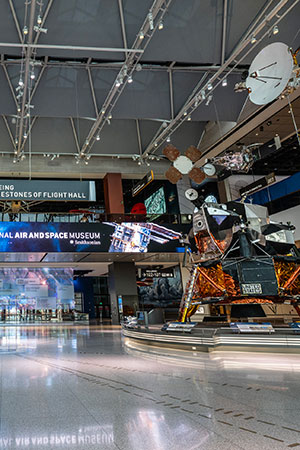
The artifacts are iconic, but from floor to ceiling the newly-reopened Boeing Milestones of Flight Hall at the National Air and Space Museum is all new. (Smithsonian National Air and Space Museum)
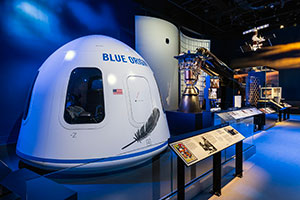
"Futures in Space" recaptures the experience of the early visitors to the National Air and Space Museum, where the objects on display were contemporary to the day. A mockup of a Blue Origin New Shepard capsule and SpaceX Merlin rocket engine are among the items on display for the first time. (National Air and Space Museum)
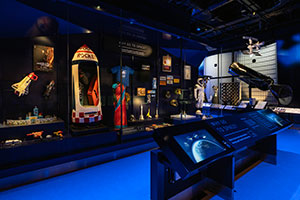
Curatores designed "Futures in Space" around a list of questions, including "Why go to space?" On display is a pressure suit worn by Sian Proctor on the Inspiration4 mission and 1978 NASA astronaut "TFNG" t-shirt. (Smithsonian National Air and Space Museum)
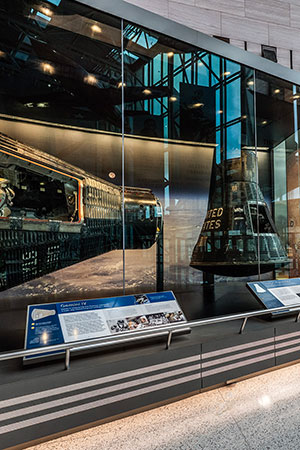
With the reopening of the Boeing Milestones of Flight Hall, visitors to the National Air and Space Museum can again see John Glenn's "Friendship 7" and Gemini 4 space capsules. (Smithsonian)
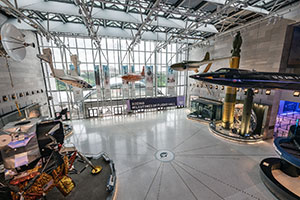
The pattern on the floor of the Boeing Milesones of Flight Hall is the pulsar-based map to Earth's solar system that was mounted to the Pioneer and Voyager probes, now updated for 2026. (Smithsonian) |
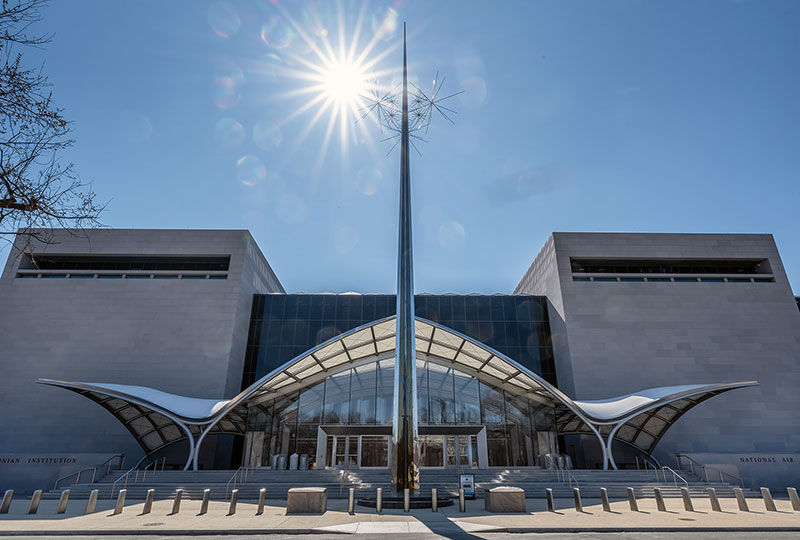
The redesigned north entrance to the Smithsonian National Air and Space Museum opened to the public on Monday, July 28, 2025. (Smithsonian) |
|

© 1999-2025 collectSPACE. All rights reserved.
|
|

|

|
